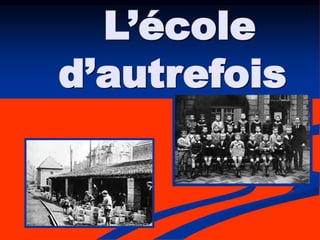Lecole dautrefois-comprehension-orale-dictionnaire-visuel 45381
•Télécharger en tant que PPT, PDF•
0 j'aime•111 vues
Lecole dautrefois-comprehension-orale-dictionnaire-visuel 45381
Signaler
Partager
Signaler
Partager

Recommandé
Recommandé
More than Just Lines on a Map: Best Practices for U.S Bike Routes
This session highlights best practices and lessons learned for U.S. Bike Route System designation, as well as how and why these routes should be integrated into bicycle planning at the local and regional level.
Presenters:
Presenter: Kevin Luecke Toole Design Group
Co-Presenter: Virginia Sullivan Adventure Cycling AssociationMore than Just Lines on a Map: Best Practices for U.S Bike Routes

More than Just Lines on a Map: Best Practices for U.S Bike RoutesProject for Public Spaces & National Center for Biking and Walking
Contenu connexe
En vedette
More than Just Lines on a Map: Best Practices for U.S Bike Routes
This session highlights best practices and lessons learned for U.S. Bike Route System designation, as well as how and why these routes should be integrated into bicycle planning at the local and regional level.
Presenters:
Presenter: Kevin Luecke Toole Design Group
Co-Presenter: Virginia Sullivan Adventure Cycling AssociationMore than Just Lines on a Map: Best Practices for U.S Bike Routes

More than Just Lines on a Map: Best Practices for U.S Bike RoutesProject for Public Spaces & National Center for Biking and Walking
En vedette (20)
Content Methodology: A Best Practices Report (Webinar)

Content Methodology: A Best Practices Report (Webinar)
How to Prepare For a Successful Job Search for 2024

How to Prepare For a Successful Job Search for 2024
Social Media Marketing Trends 2024 // The Global Indie Insights

Social Media Marketing Trends 2024 // The Global Indie Insights
Trends In Paid Search: Navigating The Digital Landscape In 2024

Trends In Paid Search: Navigating The Digital Landscape In 2024
5 Public speaking tips from TED - Visualized summary

5 Public speaking tips from TED - Visualized summary
Google's Just Not That Into You: Understanding Core Updates & Search Intent

Google's Just Not That Into You: Understanding Core Updates & Search Intent
The six step guide to practical project management

The six step guide to practical project management
Beginners Guide to TikTok for Search - Rachel Pearson - We are Tilt __ Bright...

Beginners Guide to TikTok for Search - Rachel Pearson - We are Tilt __ Bright...
Unlocking the Power of ChatGPT and AI in Testing - A Real-World Look, present...

Unlocking the Power of ChatGPT and AI in Testing - A Real-World Look, present...
More than Just Lines on a Map: Best Practices for U.S Bike Routes

More than Just Lines on a Map: Best Practices for U.S Bike Routes
Ride the Storm: Navigating Through Unstable Periods / Katerina Rudko (Belka G...

Ride the Storm: Navigating Through Unstable Periods / Katerina Rudko (Belka G...
Good Stuff Happens in 1:1 Meetings: Why you need them and how to do them well

Good Stuff Happens in 1:1 Meetings: Why you need them and how to do them well
Lecole dautrefois-comprehension-orale-dictionnaire-visuel 45381
- 2. LE XVIIIème SIÈCLE Au XVIIIème siècle, les enfants travaillaient durement toute la journée. Ils n’allaient pas à l’école.
- 3. LE XIXème SIÈCLE DANS LES USINES, DES ENFANTS EXÉCUTAIENT DES TRAVAUX QUE LES MACHINES NE POUVAIENT PAS RÉALISER. LE SALAIRE D’UN HOMME ÉTAIT DE 2 FRANCS PAR JOUR. UNE FEMME GAGNAIT 1 FRANC PAR JOUR. UN ENFANT NE RECEVAIT QU’ENTRE 45 ET 75 CMS.
- 4. LES MINES Beaucoup d’enfants travaillaientdans les mines. Leur petite taille leur permettait de se glisser dans d’étroites galeries. Leur travail consistait à pousser les wagonnets remplis de charbon. La durée du travail était de 11 à 12 heures par jour.
- 5. JULES FERRY À la fin du XIXème siècle, des lois vont interdire le travail des enfants: l’école dévient obligatoire. L’école n’étaitpas mixte. Les garçons n’apprenaient pas les mêmes choses que les filles. La religion ne se faisait pas à l’école. L’école était laïque, gratuite et obligatoire.
- 6. Les filles étaient confiées à une institutrice qui devait leur apprendre en priorité la couture, le tricot et la broderie “afin qu’elles ne soient pas à charge de leur famille en attendant d’être à la charge d’un éventuel époux”
- 7. Le matériel de classe On écrivait avec le porte plume. On apprenait les maths avec le boulier. Le professeur expliquait sur l’estrade.
- 8. Le porte-plume et les plumes : recevoir sa première plume neuve était un évènement. Avec précaution, l’écolier passait sa langue sur les deux faces pour que l’encre accroche bien. L’ardoise : premier outil qui a fait rêver les jeunes écoliers. Dans son cadre de bois, polie, vaguement luisante, sonore dès qu’on la pose sur la table.
- 9. Maintenant, à vous de parler… La campagne La ferme Les champs La moisson La récolte du blé Aider Un travail très dur
- 10. Les mines de charbon La durée Le wagonnet Pousser Glisser Remplir La petite taille Les galeries
- 11. L’industrie L’usine, le patron, l’ouvrier, les machines. Le salaire, la journée, la production.
- 12. L’école publique L’enseignement laïque, obligatoire, gratuit. Le maître, la maîtresse, les élèves. L’école, l’interdiction de travail.
- 13. Le matériel Le porte plume, l’encre, l’ardoise. L’estrade, le bureau du professeur, la carte. Le pupitre en bois.